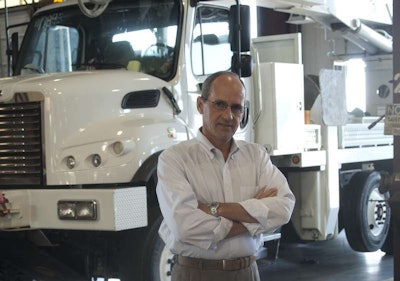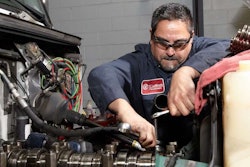 Ken Calhoun of Truck Centers of Arkansas
Ken Calhoun of Truck Centers of ArkansasLast month, I interviewed Ken Calhoun, vice president, customer relations, with Truck Centers of Arkansas, a Freightliner dealer based in North Little Rock.
Both in his role at Truck Centers of Arkansas, and through his work with the Technology and Maintenance Council, Calhoun has emerged as a leading voice calling for fundamental change in how the trucking industry recruits, trains, promotes and retains technicians.
Calhoun spoke last week at CCJ’s Fall Symposium, where he talked about his efforts to “Home Grow” his technician force at Truck Centers of Arkansas and his message of urgency to the trucking industry at large to address the looming technician crisis before it devastates fleet and freight efficiency nationwide.
The following Q&A is Calhoun’s full interview for CCJ’s report on the technician crisis. Click here to see that story, published last week online and featured in the October print edition of CCJ.
Jack Roberts, CCJ: I’ve heard some very alarming things about the technician crisis in the course of researching this story. How bad is the issue in your opinion?
Ken Calhoun: Well, I’m glad you’re covering the story. But I think you’re a little late to the party. I think we hit full-blown “Crisis Mode” five years ago. And only now are people slowly starting to realize how bad things are.
It’s a complex issue: The rate the industry has had to keep up with changes in technology – most of which has been implemented by the EPA – has driven levels of complexity into trucks today that is just unreal. I’m a reasonably intelligent man. But when I pull the tech manuals out today to try and resolve an issue, it’s a chore just to read the headlines and first five or six lines of text to extract the information I need. Since 1998, the learning curve in this industry hasn’t just steepened. It’s gone vertical.
Roberts: So it’s tough not only to find new technicians, but also keep your current techs up-to-date, correct?
Calhoun: It’s a whole new world in terms of education. The one bright spot on this front has been the advent of telematics and predictive vehicle analytics.
I was an early adopter of the first QualComm systems back in the 1980s. And even then I thought we were so close to really having something special in terms of how we handled truck breakdowns: We were maybe 3 feet away from a very simple ECM on the engine and a satellite antenna to send data. And it only took us 30 years to bridge that 3-foot gap!
Today, a lot of breakdowns have to be repaired at the Motherboard level or outsourced to the dealer. Daimler has been first with its Virtual Technician, which has hardware built into the truck at the factory. So now, we can do some basic diagnostic work in the shop once again: We have a little bit of an advantage because the system gives us a direction to move in.
The key now is we’re starting to get good, usable data to make decisions with – specific codes tied to a problem along with the typical repair needed to address the issue. These are all new things that help me more than hinder me when I need to get a truck back on the road.
Roberts: You’re an advocate of “Developing your Bench” when it comes to technicians. Can you explain that philosophy?
Calhoun: First, you have realize that now, as our industry has become a global one, it has vastly limited a fleet’s talent pool in terms of hiring a technician that’s already in the field.
Say you’ve got a technician at my competitor across the street who is disgruntled and wants to leave. In the old days, he’d be a prime candidate to recruit. But today, I would have to spend the same amount of time and money to retrain him on our brand and technology as I would to train somebody just coming out of tech school. Our products are so different, and structured and designed so differently a technician today is severely limited in the systems he can work on with a new brand without going back to school.
Worse, there’s a certain level of chaos in the industry among the OEMs designing the equipment. Cat is out. Navistar is still hanging in there. What’s the issue? Technology. Or rather, the wrong technology. Fleets and technicians today are faced with challenges and technology coming at us that we have to work on while the engineers who designed the stuff in the first place are still figuring out how to diagnose and recommend repair procedures. It’s a mess.
What all this means for a fleet is that the days of poaching talent are over. You have to bring people into your organization, train them, and then retain them. The first step, obviously, is creating an apprenticeship program to identify and track talented newcomers. Fleets have always done this, to a degree. But a much fancier approach is required today. And you have to be realistic. Once you find talent, you can expect a 50 percent washout rate from any group of students you decide to work with. And that has held true for us.
The key to this is finding partners that can provide you with a steady stream of talent. And for us, that has been the biggest challenge. I’ve been lobbying my bosses to take an EPA ’10 compliant truck and donate it to a partner school. And saying to that school, “Here’s the truck, the diagnostic suite, and the sign-on passwords to look at the diagnostic codes. Take it and use it to educate your students. And in return, give me the first shot at your best students and know that I’ll take 12 graduates a year into my business. Because that’s the number of new technicians I need to keep just one facility up and running each year.
Roberts: Technical schools just don’t have the money to get the latest hardware to teach with, do they?
Calhoun: They’re 15 years behind the curve right now. I provided an engine to one of our vocational schools here in Little Rock 17 years ago. And they’re still training with that same engine today. And they’re in better shape than most schools. I’ve gone into schools recently and seen students working on old Detroit two-cycle engines. That training is useless today, beyond very basic instruction on diesel engine theory.
Roberts: But the kids are still going to the schools. That’s a positive, right?
Calhoun: Yeah. But we also have to start reaching out to those kids at a much earlier age. Both the kids and their parents. We need to be talking to kids and their parents when they’re in junior high school and telling them there is real earning potential for technicians in this industry. We need to think long-term. Instead, we’re always in panic mode because we need technicians and it’s all about short-term, instant gratification.
Roberts: What’s your advice for fleets struggling with finding good technicians today?
Calhoun: If I could say anything to fleets out there today, I’d urge them to look hard at the structures and procedures they have in place. You have to remember, no one piece can be put in and suddenly your problem is solved. It may take multiple changes to get things turned around and be successful.
The other thing you must do is look hard at the people charged with training both your new, and senior, technicians. I cannot stress enough the importance of having a Mentor Program in place on the shop floor. You need to have your experienced, senior technicians involved and working with new technicians and instructing them when they’re out on the floor. Instruction can no longer just take place in the classroom.
And you have to make sure your Mentors understand this is absolutely key for your fleet or dealership’s success. It can’t be something they see as irritating or extra work. That’s why our people are rewarded for serving as mentors. They understand what our expectations are for them and the people we’re asking them to work with. They understand we expect them to groom these youngsters to be the good workers and future leaders we need to succeed today and in the future. At the same time we need all our technicians to know that the path for their professional growth is clear and they know what they have to do in order to advance along that path.










